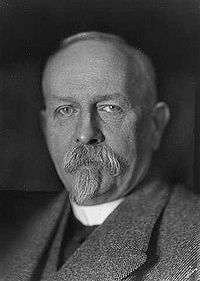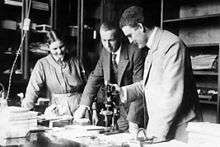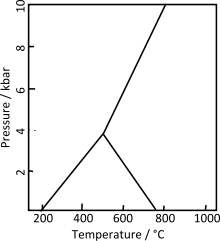Victor Goldschmidt
| Victor Moritz Goldschmidt | |
|---|---|
 Young Victor Goldschmidt | |
| Born |
January 27, 1888 Zürich, Switzerland |
| Died |
March 20, 1947 (aged 59) Oslo, Norway |
| Alma mater | University of Oslo |
| Known for | Geochemistry |
| Awards |
Foreign Member of the Royal Society Elliott Cresson Medal (1903) Wollaston Medal (1944) |
| Scientific career | |
| Fields | Geochemistry |
| Institutions | University of Oslo |
| Thesis | Die Kontaktmetamorphose im Kristianiagebiet and Geologisch-petrographische Studien im Hochgebirge des südlichen Norwegens (1911) |
| Doctoral advisor | Waldemar C. Brøgger |
| Doctoral students | Brian Harold Mason |
| Influenced | Alfred Edward Ringwood |
Victor Moritz Goldschmidt ForMemRS (January 27, 1888 in Zürich – March 20, 1947 in Oslo) was a Norwegian mineralogist considered (together with Vladimir Vernadsky) to be the founder of modern geochemistry and crystal chemistry, developer of the Goldschmidt Classification of elements.
Early life and education
Goldschmidt was born in Zürich, Switzerland on January 27, 1888.[1]:7 His father, Heinrich Jacob Goldschmidt, (1857–1937) was a physical chemist at the Eidgenössisches Polytechnikum and his mother, Amelie Koehne (1864–1929), was the daughter of a lumber merchant. They named him Viktor after a colleague of Heinrich, Victor Meyer. His father's family was pure Jewish back to at least 1600 and mostly highly educated, with rabbis, judges, lawyers and military officers among their numbers.[2] As his father's career progressed, the family moved first to Amsterdam in 1893, to Heidelberg in 1896, and finally to Kristiania (later Oslo), Norway in 1901, where he took over the physical chemistry chair at the university. The family became Norwegian citizens in 1905.[3]

Goldschmidt entered the University of Kristiana (later the University of Oslo) in 1906 and studied inorganic and physical chemistry, geology, mineralogy, physics, mathematics, zoology and botany.[3] He secured a fellowship for his doctoral studies from the university at the age of 21 (1909). He worked on his thesis with the noted geologist Waldemar Christofer Brøgger and obtained his Norwegian doctor’s degree when he was 23 years old (1911). For his dissertation titled Die Kontaktmetamorphose im Kristianiagebiet ("The Contact Metamorphism in the Kristiania Region"), the Norwegian Academy of Sciences awarded him the Fridtjof Nansen award in 1912. The same year he was made Docent (Associate Professor) of Mineralogy and Petrography at the university.[3]
Career
In 1914 Goldschmidt applied for a professorship in Stockholm and was offered the position. To entice him to stay, the University of Kristiania persuaded the government to establish a Mineralogical Institute with a professorship for him.[2]:19 In 1929 Goldschmidt was appointed the chair of mineralogy in Göttingen, and he hired Reinhold Mannkopff and Fritz Laves as his assistants.[2]:54,58 However, after the rise of the Nazis to power, he became unhappy with the treatment of non-Aryans like himself (although the university treated him well) and he resigned in 1935 and returned to Oslo.[4]:21
On 9 April 1940, the Germans invaded Norway. On October 26, 1942, Goldschmidt was arrested at the orders of the German occupying powers as part of the persecution of Jews in Norway during World War II. Taken to the Berg concentration camp, he became seriously ill and after a stay in a hospital near Oslo, he was released on 8 November, only to be rearrested on 25 November. However, as he was on the pier and about to be deported to Auschwitz, he was freed because some colleagues had persuaded the chief of police that his scientific expertise was essential to the state.[4]:22 Goldschmidt soon fled to Sweden.[4]:23
Goldschmidt was flown to England on March 3, 1943 by a British intelligence unit, and provided information about technical developments in Norway. After a short period of uncertainty about his future status, he was assigned to the Macaulay Institute for Soil Research (in Aberdeen) of the Agricultural Research Council. He participated in discussions about the German use of raw materials and production of heavy water. He attended open meetings in Cambridge, Manchester, Sheffield, Edinburgh and Aberdeen and lectured at the British Coal Utilisation Research Association on the presence of rare elements in coal ash.[5][4]:24 His British professional associates and contacts included Leonard Hawkes, C E Tilley and W H Bragg, J D Bernal, Dr W G (later Sir William) Ogg.[4]:18,24
Goldschmidt moved from Aberdeen to Rothamsted, where he was popular and nicknamed ‘Goldie’. However, he wanted to go back to Oslo – not welcomed by all Norwegians – and returned there on 26 June 1946, but died soon after, at age 59.[4]:26
Scientific work

For his thesis, Goldschmidt studied the Oslo graben, a valley formed by the downward displacement of a block of land along faults on each side. The region had recently been mapped by Brøgger. In the Permian, magmas intruded into the older rocks, heating the surrounding rock. This resulted in mineralogical changes known as contact metamorphism, resulting in a fine-grained class of rocks known as hornfels. Goldschmidt made a systematic study of the hornfels. He showed that, of the minerals to be found in the hornfels, only certain associations occurred. For example, andalusite could be associated with cordierite but never with hypersthene.[2]:13–14

From his data on the hornfels, Goldschmidt deduced a mineralogical phase rule. It is a special case of the Gibb's phase rule for phases in thermodynamic equilibrium with each other, which states that
where C is the minimum number of chemical components, P is the number of phases, and F is the number of degrees of freedom (e.g., temperature and pressure) that can vary without changing C or P. As an example, the chemical compound Al2SiO5 can occur naturally as three different minerals: andalusite, kyanite and sillimanite. There is a single component (C = 1), so if all three minerals coexist (P = 3), then F = 0. That is, there are no degrees of freedom, so there is only one possible combination of pressure and temperature. This corresponds to the triple point in the phase diagram.[2]:15–16
If the same mineral association is found in several rocks over some region, it must have crystallized at a range of temperatures and pressures. In that case, F must have been at least 2, so
This expresses Goldschmidt's mineralogical phase rule: the number of phases is no greater than the number of components.[7][8]
In the early 20th century, Max von Laue and William L. Bragg showed that X-ray scattering could be used to determine the structures of crystals. In the 1920s and 1930s, Goldschmidt and associates at Oslo and Göttingen applied these methods to many common minerals and formulated a set of rules for how elements are grouped. Goldschmidt published this work in the series Geochemische Verteilungsgesetze der Elemente [Geochemical Laws of the Distribution of Elements].[9]:2[10]
Publications
A textbook, Geochemistry, was edited and published posthumously in England in 1954.[4]:30
Awards
Goldschmidt was created a Knight of the Order of St. Olav in 1929.[3]
While at the Macaulay Institute, Goldschmidt was elected a Foreign Member of the Royal Society,[1] given an honorary Doctor of Laws (LLD) by the University of Aberdeen and awarded the Wollaston Medal, the highest honor of the Geological Society of London.[4]
The mountain ridge Goldschmidtfjella in Oscar II Land at Spitsbergen is named after him.[11]
See also
References
- 1 2 Tilley, C. E. (1948). "Victor Moritz Goldschmidt. 1888-1947". Obituary Notices of Fellows of the Royal Society. 6 (17): 51. doi:10.1098/rsbm.1948.0019. JSTOR 768911.
- 1 2 3 4 5 Mason, Brian (1992). Victor Moritz Goldschmidt : father of modern geochemistry. Geochemical Society. ISBN 0-941809-03-X. Retrieved 6 October 2018.
- 1 2 3 4 Kauffman, George B. (November 1997). "Victor Moritz Goldschmidt (1888–1947): A Tribute to the Founder of Modern Geochemistry on the Fiftieth Anniversary of His Death". The Chemical Educator. 2 (5): 1–26. doi:10.1007/s00897970143a.
- 1 2 3 4 5 6 7 8 Glasby, G. P. (October 2006). "V. M. Goldschmidt: The British connection". The Geochemical News. 129: 14&ndash, 31. Retrieved 5 October 2018.
- ↑ Glasby, Geoff (March 2007). "Goldschmidt in Britain". Geoscientist. Geological Society. 17 (3). Retrieved 12 January 2011.
- ↑ Whitney, Donna L. (April 2002). "Coexisting andalusite, kyanite, and sillimanite: Sequential formation of three AlSiO5 polymorphs during progressive metamorphism near the triple point, Sivrihisar, Turkey". American Mineralogist. 87 (4): 405–416. doi:10.2138/am-2002-0404.
- ↑ Fritscher, Bernard (2002). "Metamorphism and thermodynamics: the formative years". In Oldroyd, David Roger. The earth inside and out : some major contributions to geology in the twentieth century. Geological Society of London. pp. 143–162. ISBN 9781862390966.
- ↑ Miyashiro, Akiho (1994). Metamorphic petrology. CRC Press. pp. 110–111. ISBN 9781857280371.
- ↑ McSween, Jr., Harry Y.; Richardson, Steven M.; Uhle, Maria E. (2003). Geochemistry pathways and processes (2nd ed.). New York: Columbia University. ISBN 9780231509039.
- ↑ Mason, Brian (1992). Victor Moritz Goldschmidt : father of modern geochemistry. San Antonio, Tex.: Geochemical Society. ISBN 0-941809-03-X.
- ↑ "Goldschmidtfjella (Svalbard)". Norwegian Polar Institute. Retrieved 6 October 2018.
Further reading
- Baur, Werner H. (17 February 2014). "One hundred years of inorganic crystal chemistry – a personal view". Crystallography Reviews. 20 (2): 64–116. doi:10.1080/0889311X.2013.879648.
- Brown, Jr., Gordon; Calas, Georges (October 2012 – January 2013). "Mineral-aqueous solution interfaces and their impact on the environment". Geochemical Perspectives. 1 (4–5): 509–510. doi:10.7185/geochempersp.1.4.
- Correns, C. W. (1947). "Victor Moritz Goldschmidt". Die Naturwissenschaften. 34 (5): 129–131. Bibcode:1947NW.....34..129C. doi:10.1007/BF00623407.
- Levinson, A.A.; Sclar, C.B. (July 1988). "Victor Moritz Goldschmidt (1888–1947): a pictorial tribute". Applied Geochemistry. 3 (4): 393–414. doi:10.1016/0883-2927(88)90120-5.
- Ottosen, Kristian, ed. (2004). Nordmenn i fangenskap 1940–1945 [Norwegians in captivity 1940–1945] (in Norwegian) (2nd ed.). Oslo: Universitetsforlaget. p. 241. ISBN 82-15-00288-9.
- Reinhardt, Carsten (2008). "Victor Moritz Goldschmidt and the transition from geo- to cosmochemistry". Chemical sciences in the 20th century : bridging boundaries. John Wiley & Sons. pp. 169–175. ISBN 9783527612741.
- Rosbaud, P. (1961). "Victor Moritz Goldschmidt 1888–1947". In Faber, E. Great Chemists. New York, NY: Interscience Publishers. pp. 1563–1586. ISBN 9780470254769.
- Scheumann, K. H. (1948). "Victor Moritz Goldschmidt". Geologische Rundschau. 35 (2): 179–180. Bibcode:1948GeoRu..35..179S. doi:10.1007/BF01764480.
- Spencer, L. J. (December 1947). "Biographical notices of mineralogists recently deceased. (Eighth series.) Victor Goldschmidt (1888-1947)" (pdf). Mineralogical Magazine. 28 (199): 195–196. Retrieved 5 October 2018.
- Wedepohl, K. Hans (April 1996). "The importance of the pioneering work by V. M. Goldschmidt for modern geochemistry". Naturwissenschaften. 83 (4): 165–171. doi:10.1007/BF01143057.
- Weintraub, B (December 2005). "Victor Moritz Goldschmidt (1888-1947): Father of Modern Geochemistry and of Crystal Chemistry" (PDF). Bull. Isr. Chem. Soc. 20: 42–46. Archived from the original (pdf) on 21 July 2011.